Business Leadership: Case Study Analysis of Metro Bank and Nissan
VerifiedAdded on 2020/01/15
|7
|1819
|162
Case Study
AI Summary
This case study analysis examines the leadership approaches employed at Metro Bank and Nissan. The first case study focuses on Metro Bank, where Marsha, a new manager, implements various leadership qualities to address issues like low employee morale and productivity. She utilizes visionary, organizational, motivational, and decision-making skills to improve employee engagement, implement cross-training, and foster a positive work environment. The second case study analyzes Carlos Ghosn's leadership at Nissan, highlighting his use of charismatic and transactional leadership styles to revive the company. Ghosn implements participative management, addresses cross-cultural issues, and applies Lewin's three-step organizational framework to drive significant changes, including restructuring and cost reduction. The analysis provides insights into how these leaders tackled organizational challenges and achieved positive outcomes through strategic leadership and change management.
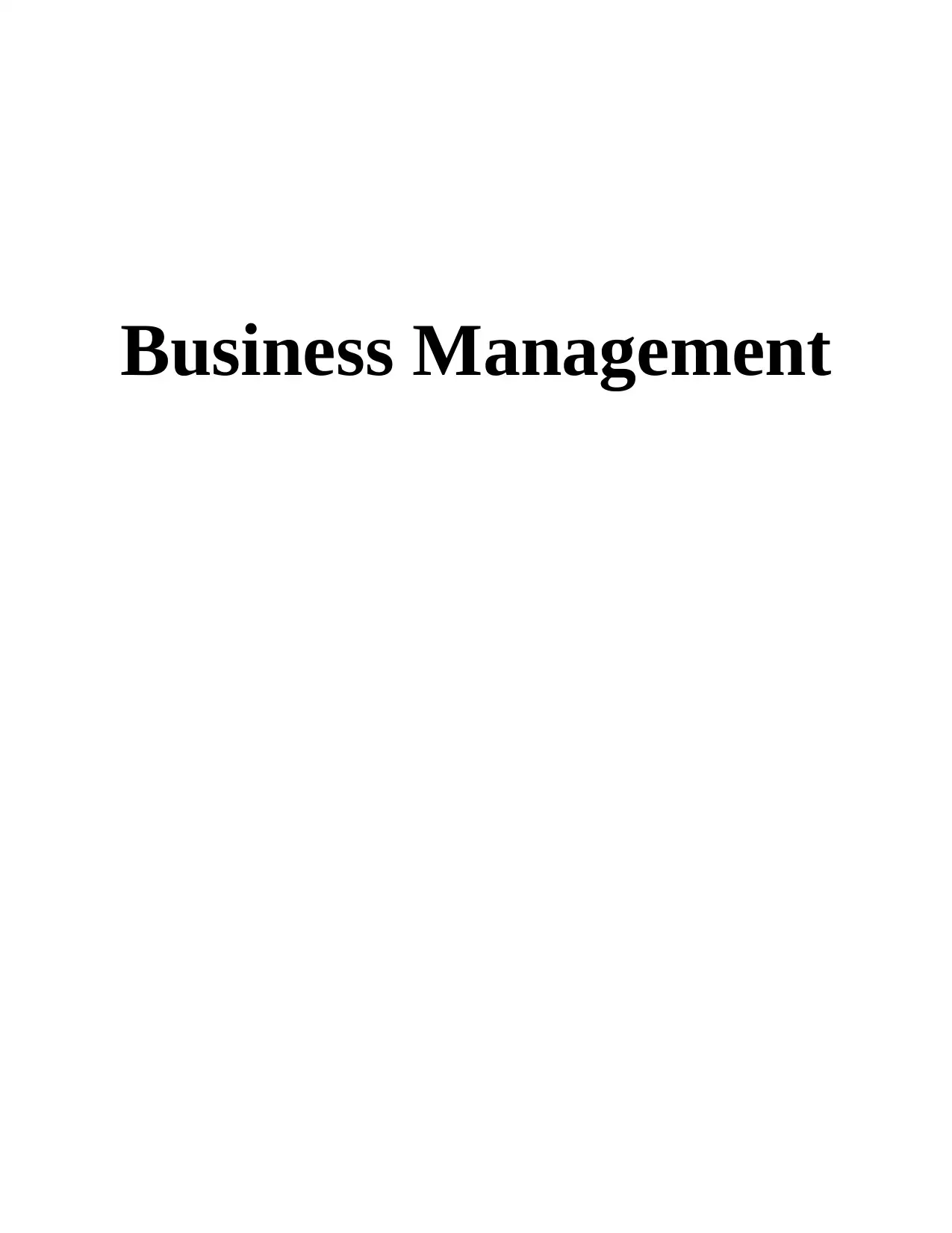
Business Management
Paraphrase This Document
Need a fresh take? Get an instant paraphrase of this document with our AI Paraphraser
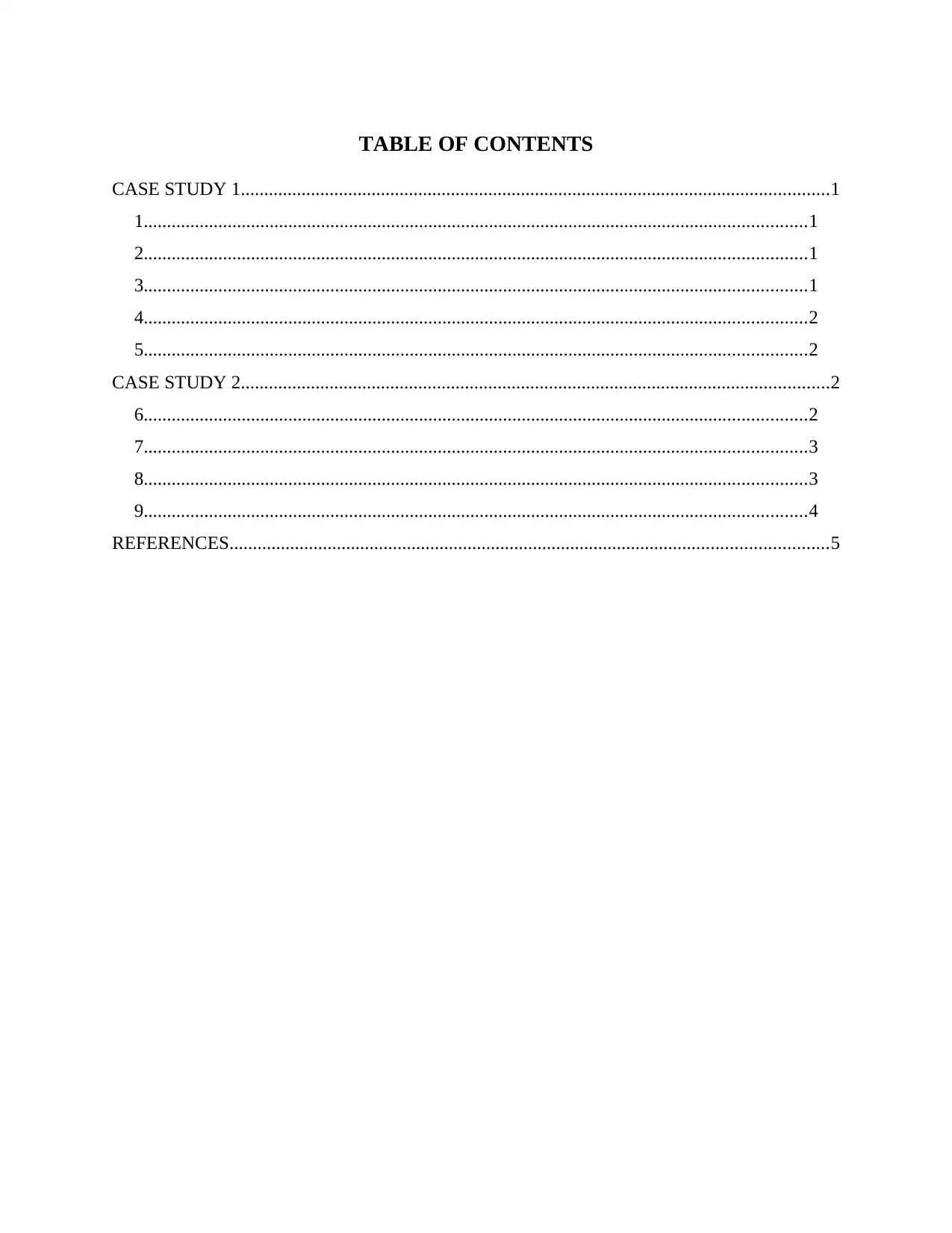
TABLE OF CONTENTS
CASE STUDY 1..............................................................................................................................1
1..............................................................................................................................................1
2..............................................................................................................................................1
3..............................................................................................................................................1
4..............................................................................................................................................2
5..............................................................................................................................................2
CASE STUDY 2..............................................................................................................................2
6..............................................................................................................................................2
7..............................................................................................................................................3
8..............................................................................................................................................3
9..............................................................................................................................................4
REFERENCES................................................................................................................................5
CASE STUDY 1..............................................................................................................................1
1..............................................................................................................................................1
2..............................................................................................................................................1
3..............................................................................................................................................1
4..............................................................................................................................................2
5..............................................................................................................................................2
CASE STUDY 2..............................................................................................................................2
6..............................................................................................................................................2
7..............................................................................................................................................3
8..............................................................................................................................................3
9..............................................................................................................................................4
REFERENCES................................................................................................................................5
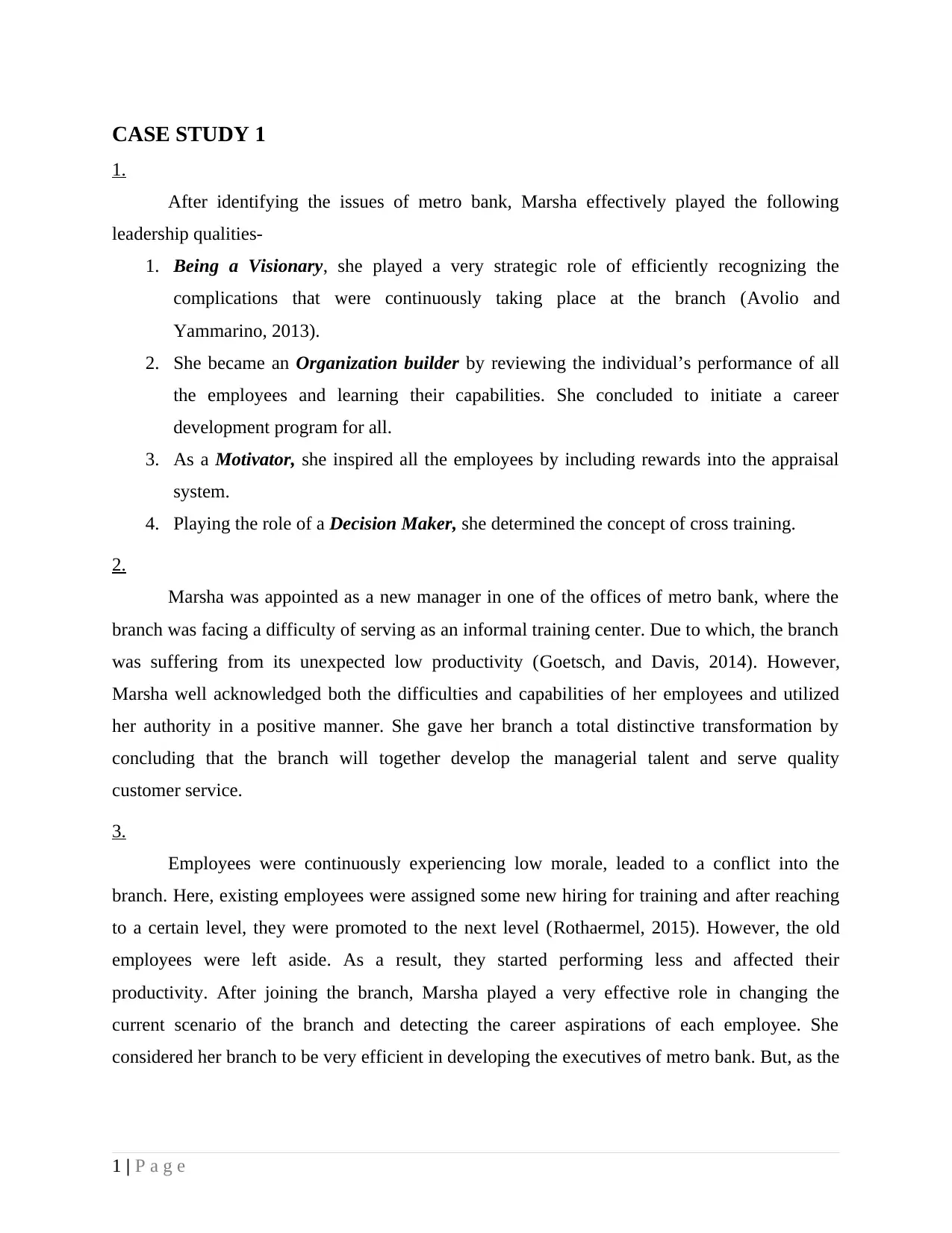
CASE STUDY 1
1.
After identifying the issues of metro bank, Marsha effectively played the following
leadership qualities-
1. Being a Visionary, she played a very strategic role of efficiently recognizing the
complications that were continuously taking place at the branch (Avolio and
Yammarino, 2013).
2. She became an Organization builder by reviewing the individual’s performance of all
the employees and learning their capabilities. She concluded to initiate a career
development program for all.
3. As a Motivator, she inspired all the employees by including rewards into the appraisal
system.
4. Playing the role of a Decision Maker, she determined the concept of cross training.
2.
Marsha was appointed as a new manager in one of the offices of metro bank, where the
branch was facing a difficulty of serving as an informal training center. Due to which, the branch
was suffering from its unexpected low productivity (Goetsch, and Davis, 2014). However,
Marsha well acknowledged both the difficulties and capabilities of her employees and utilized
her authority in a positive manner. She gave her branch a total distinctive transformation by
concluding that the branch will together develop the managerial talent and serve quality
customer service.
3.
Employees were continuously experiencing low morale, leaded to a conflict into the
branch. Here, existing employees were assigned some new hiring for training and after reaching
to a certain level, they were promoted to the next level (Rothaermel, 2015). However, the old
employees were left aside. As a result, they started performing less and affected their
productivity. After joining the branch, Marsha played a very effective role in changing the
current scenario of the branch and detecting the career aspirations of each employee. She
considered her branch to be very efficient in developing the executives of metro bank. But, as the
1 | P a g e
1.
After identifying the issues of metro bank, Marsha effectively played the following
leadership qualities-
1. Being a Visionary, she played a very strategic role of efficiently recognizing the
complications that were continuously taking place at the branch (Avolio and
Yammarino, 2013).
2. She became an Organization builder by reviewing the individual’s performance of all
the employees and learning their capabilities. She concluded to initiate a career
development program for all.
3. As a Motivator, she inspired all the employees by including rewards into the appraisal
system.
4. Playing the role of a Decision Maker, she determined the concept of cross training.
2.
Marsha was appointed as a new manager in one of the offices of metro bank, where the
branch was facing a difficulty of serving as an informal training center. Due to which, the branch
was suffering from its unexpected low productivity (Goetsch, and Davis, 2014). However,
Marsha well acknowledged both the difficulties and capabilities of her employees and utilized
her authority in a positive manner. She gave her branch a total distinctive transformation by
concluding that the branch will together develop the managerial talent and serve quality
customer service.
3.
Employees were continuously experiencing low morale, leaded to a conflict into the
branch. Here, existing employees were assigned some new hiring for training and after reaching
to a certain level, they were promoted to the next level (Rothaermel, 2015). However, the old
employees were left aside. As a result, they started performing less and affected their
productivity. After joining the branch, Marsha played a very effective role in changing the
current scenario of the branch and detecting the career aspirations of each employee. She
considered her branch to be very efficient in developing the executives of metro bank. But, as the
1 | P a g e
⊘ This is a preview!⊘
Do you want full access?
Subscribe today to unlock all pages.

Trusted by 1+ million students worldwide
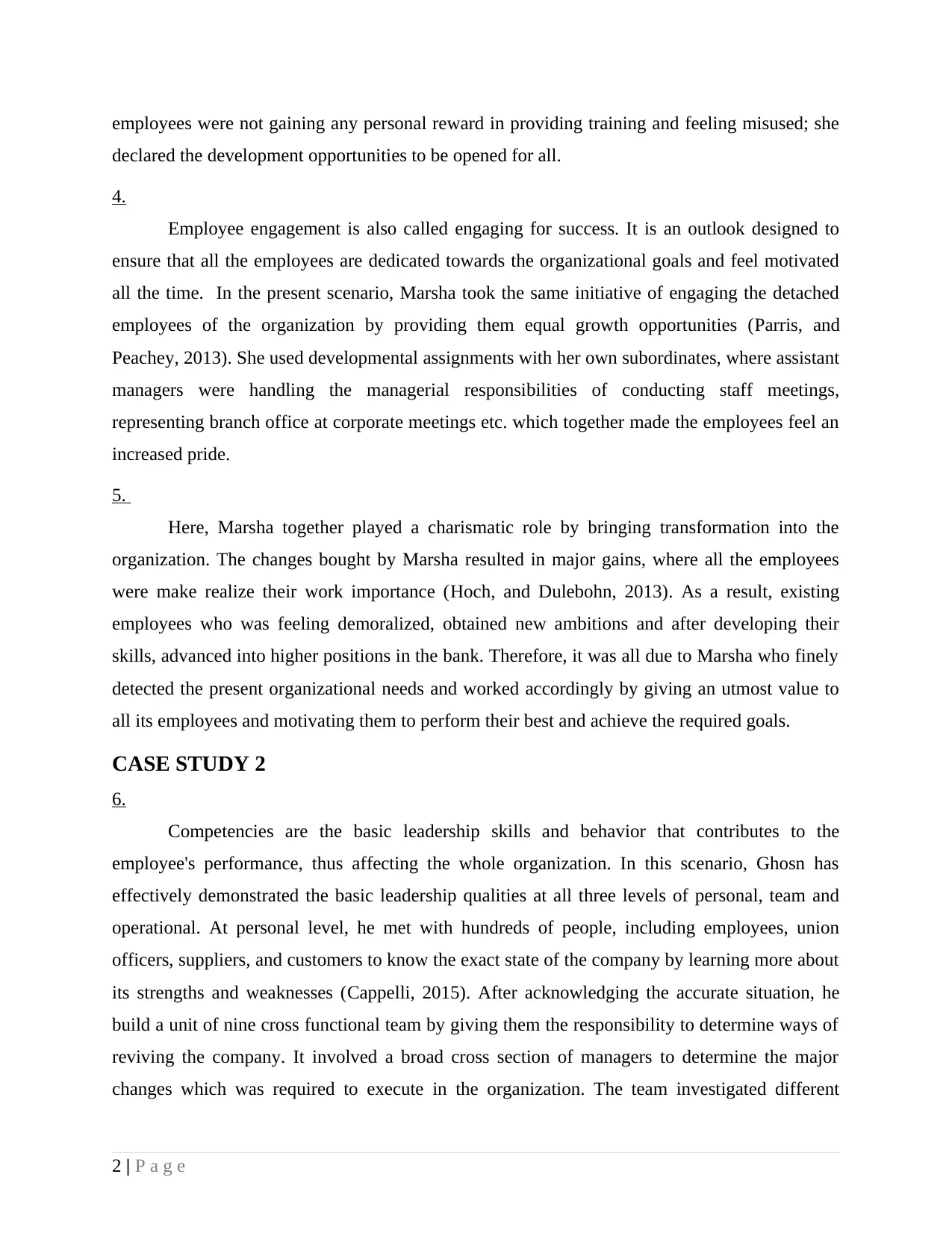
employees were not gaining any personal reward in providing training and feeling misused; she
declared the development opportunities to be opened for all.
4.
Employee engagement is also called engaging for success. It is an outlook designed to
ensure that all the employees are dedicated towards the organizational goals and feel motivated
all the time. In the present scenario, Marsha took the same initiative of engaging the detached
employees of the organization by providing them equal growth opportunities (Parris, and
Peachey, 2013). She used developmental assignments with her own subordinates, where assistant
managers were handling the managerial responsibilities of conducting staff meetings,
representing branch office at corporate meetings etc. which together made the employees feel an
increased pride.
5.
Here, Marsha together played a charismatic role by bringing transformation into the
organization. The changes bought by Marsha resulted in major gains, where all the employees
were make realize their work importance (Hoch, and Dulebohn, 2013). As a result, existing
employees who was feeling demoralized, obtained new ambitions and after developing their
skills, advanced into higher positions in the bank. Therefore, it was all due to Marsha who finely
detected the present organizational needs and worked accordingly by giving an utmost value to
all its employees and motivating them to perform their best and achieve the required goals.
CASE STUDY 2
6.
Competencies are the basic leadership skills and behavior that contributes to the
employee's performance, thus affecting the whole organization. In this scenario, Ghosn has
effectively demonstrated the basic leadership qualities at all three levels of personal, team and
operational. At personal level, he met with hundreds of people, including employees, union
officers, suppliers, and customers to know the exact state of the company by learning more about
its strengths and weaknesses (Cappelli, 2015). After acknowledging the accurate situation, he
build a unit of nine cross functional team by giving them the responsibility to determine ways of
reviving the company. It involved a broad cross section of managers to determine the major
changes which was required to execute in the organization. The team investigated different
2 | P a g e
declared the development opportunities to be opened for all.
4.
Employee engagement is also called engaging for success. It is an outlook designed to
ensure that all the employees are dedicated towards the organizational goals and feel motivated
all the time. In the present scenario, Marsha took the same initiative of engaging the detached
employees of the organization by providing them equal growth opportunities (Parris, and
Peachey, 2013). She used developmental assignments with her own subordinates, where assistant
managers were handling the managerial responsibilities of conducting staff meetings,
representing branch office at corporate meetings etc. which together made the employees feel an
increased pride.
5.
Here, Marsha together played a charismatic role by bringing transformation into the
organization. The changes bought by Marsha resulted in major gains, where all the employees
were make realize their work importance (Hoch, and Dulebohn, 2013). As a result, existing
employees who was feeling demoralized, obtained new ambitions and after developing their
skills, advanced into higher positions in the bank. Therefore, it was all due to Marsha who finely
detected the present organizational needs and worked accordingly by giving an utmost value to
all its employees and motivating them to perform their best and achieve the required goals.
CASE STUDY 2
6.
Competencies are the basic leadership skills and behavior that contributes to the
employee's performance, thus affecting the whole organization. In this scenario, Ghosn has
effectively demonstrated the basic leadership qualities at all three levels of personal, team and
operational. At personal level, he met with hundreds of people, including employees, union
officers, suppliers, and customers to know the exact state of the company by learning more about
its strengths and weaknesses (Cappelli, 2015). After acknowledging the accurate situation, he
build a unit of nine cross functional team by giving them the responsibility to determine ways of
reviving the company. It involved a broad cross section of managers to determine the major
changes which was required to execute in the organization. The team investigated different
2 | P a g e
Paraphrase This Document
Need a fresh take? Get an instant paraphrase of this document with our AI Paraphraser
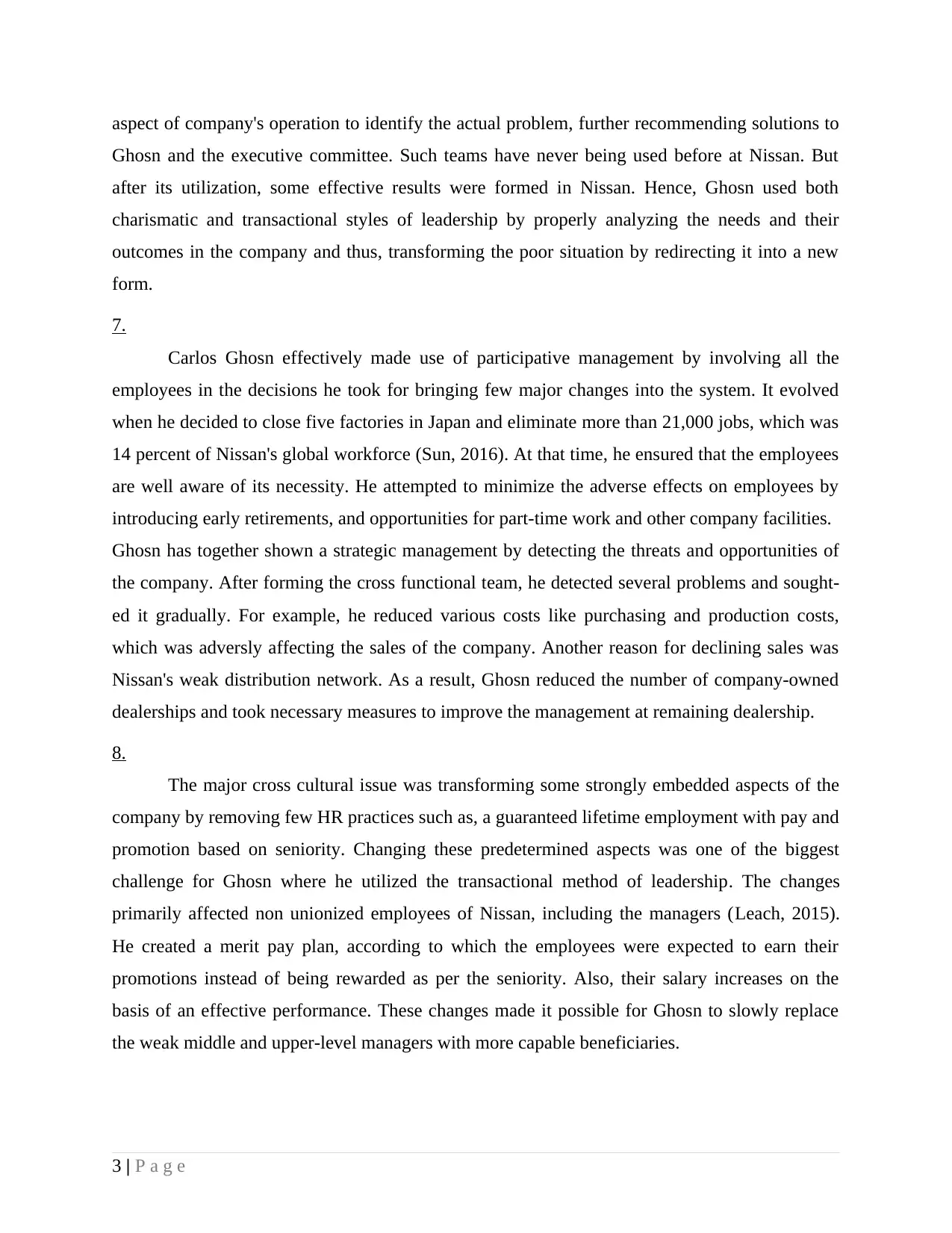
aspect of company's operation to identify the actual problem, further recommending solutions to
Ghosn and the executive committee. Such teams have never being used before at Nissan. But
after its utilization, some effective results were formed in Nissan. Hence, Ghosn used both
charismatic and transactional styles of leadership by properly analyzing the needs and their
outcomes in the company and thus, transforming the poor situation by redirecting it into a new
form.
7.
Carlos Ghosn effectively made use of participative management by involving all the
employees in the decisions he took for bringing few major changes into the system. It evolved
when he decided to close five factories in Japan and eliminate more than 21,000 jobs, which was
14 percent of Nissan's global workforce (Sun, 2016). At that time, he ensured that the employees
are well aware of its necessity. He attempted to minimize the adverse effects on employees by
introducing early retirements, and opportunities for part-time work and other company facilities.
Ghosn has together shown a strategic management by detecting the threats and opportunities of
the company. After forming the cross functional team, he detected several problems and sought-
ed it gradually. For example, he reduced various costs like purchasing and production costs,
which was adversly affecting the sales of the company. Another reason for declining sales was
Nissan's weak distribution network. As a result, Ghosn reduced the number of company-owned
dealerships and took necessary measures to improve the management at remaining dealership.
8.
The major cross cultural issue was transforming some strongly embedded aspects of the
company by removing few HR practices such as, a guaranteed lifetime employment with pay and
promotion based on seniority. Changing these predetermined aspects was one of the biggest
challenge for Ghosn where he utilized the transactional method of leadership. The changes
primarily affected non unionized employees of Nissan, including the managers (Leach, 2015).
He created a merit pay plan, according to which the employees were expected to earn their
promotions instead of being rewarded as per the seniority. Also, their salary increases on the
basis of an effective performance. These changes made it possible for Ghosn to slowly replace
the weak middle and upper-level managers with more capable beneficiaries.
3 | P a g e
Ghosn and the executive committee. Such teams have never being used before at Nissan. But
after its utilization, some effective results were formed in Nissan. Hence, Ghosn used both
charismatic and transactional styles of leadership by properly analyzing the needs and their
outcomes in the company and thus, transforming the poor situation by redirecting it into a new
form.
7.
Carlos Ghosn effectively made use of participative management by involving all the
employees in the decisions he took for bringing few major changes into the system. It evolved
when he decided to close five factories in Japan and eliminate more than 21,000 jobs, which was
14 percent of Nissan's global workforce (Sun, 2016). At that time, he ensured that the employees
are well aware of its necessity. He attempted to minimize the adverse effects on employees by
introducing early retirements, and opportunities for part-time work and other company facilities.
Ghosn has together shown a strategic management by detecting the threats and opportunities of
the company. After forming the cross functional team, he detected several problems and sought-
ed it gradually. For example, he reduced various costs like purchasing and production costs,
which was adversly affecting the sales of the company. Another reason for declining sales was
Nissan's weak distribution network. As a result, Ghosn reduced the number of company-owned
dealerships and took necessary measures to improve the management at remaining dealership.
8.
The major cross cultural issue was transforming some strongly embedded aspects of the
company by removing few HR practices such as, a guaranteed lifetime employment with pay and
promotion based on seniority. Changing these predetermined aspects was one of the biggest
challenge for Ghosn where he utilized the transactional method of leadership. The changes
primarily affected non unionized employees of Nissan, including the managers (Leach, 2015).
He created a merit pay plan, according to which the employees were expected to earn their
promotions instead of being rewarded as per the seniority. Also, their salary increases on the
basis of an effective performance. These changes made it possible for Ghosn to slowly replace
the weak middle and upper-level managers with more capable beneficiaries.
3 | P a g e
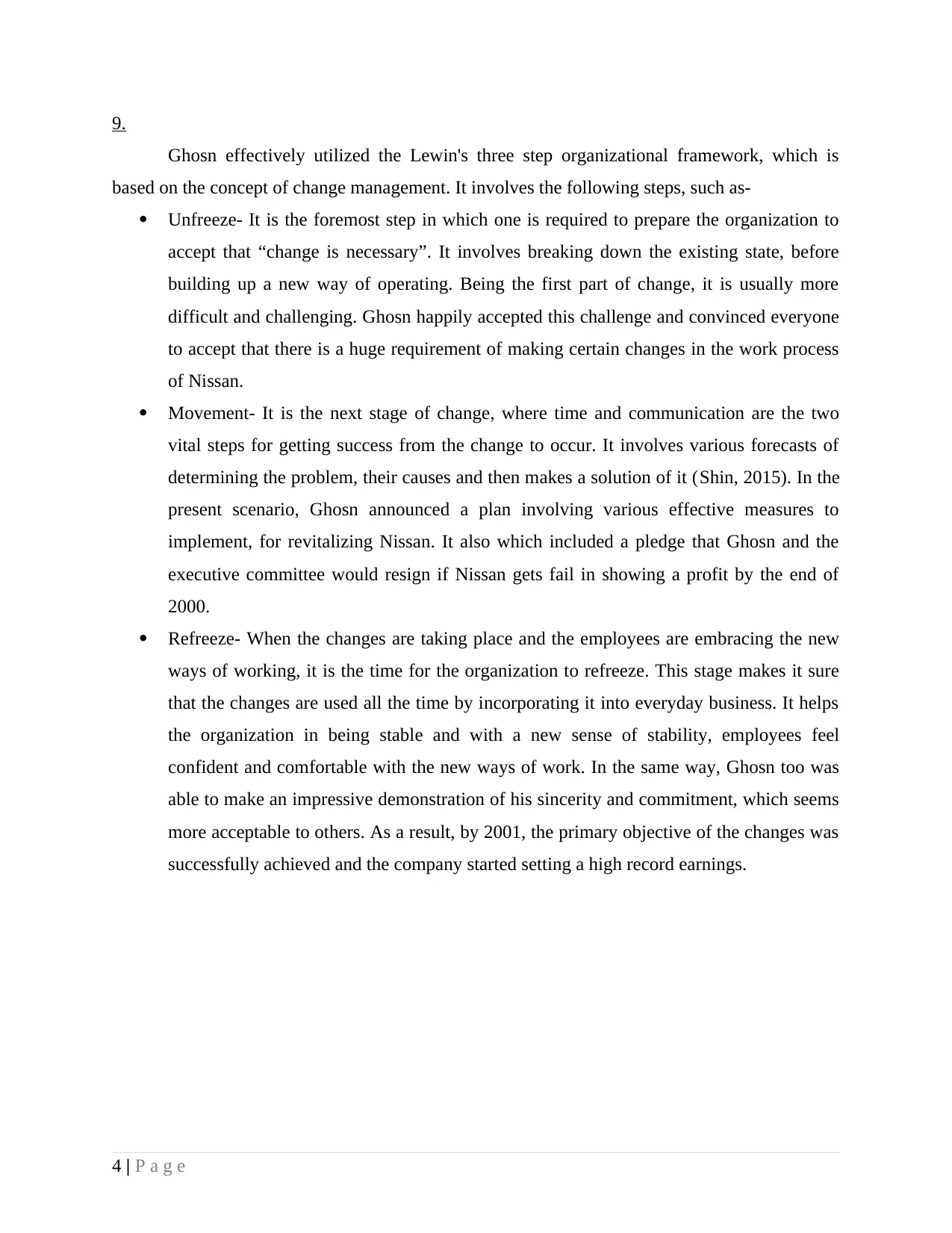
9.
Ghosn effectively utilized the Lewin's three step organizational framework, which is
based on the concept of change management. It involves the following steps, such as-
Unfreeze- It is the foremost step in which one is required to prepare the organization to
accept that “change is necessary”. It involves breaking down the existing state, before
building up a new way of operating. Being the first part of change, it is usually more
difficult and challenging. Ghosn happily accepted this challenge and convinced everyone
to accept that there is a huge requirement of making certain changes in the work process
of Nissan.
Movement- It is the next stage of change, where time and communication are the two
vital steps for getting success from the change to occur. It involves various forecasts of
determining the problem, their causes and then makes a solution of it (Shin, 2015). In the
present scenario, Ghosn announced a plan involving various effective measures to
implement, for revitalizing Nissan. It also which included a pledge that Ghosn and the
executive committee would resign if Nissan gets fail in showing a profit by the end of
2000.
Refreeze- When the changes are taking place and the employees are embracing the new
ways of working, it is the time for the organization to refreeze. This stage makes it sure
that the changes are used all the time by incorporating it into everyday business. It helps
the organization in being stable and with a new sense of stability, employees feel
confident and comfortable with the new ways of work. In the same way, Ghosn too was
able to make an impressive demonstration of his sincerity and commitment, which seems
more acceptable to others. As a result, by 2001, the primary objective of the changes was
successfully achieved and the company started setting a high record earnings.
4 | P a g e
Ghosn effectively utilized the Lewin's three step organizational framework, which is
based on the concept of change management. It involves the following steps, such as-
Unfreeze- It is the foremost step in which one is required to prepare the organization to
accept that “change is necessary”. It involves breaking down the existing state, before
building up a new way of operating. Being the first part of change, it is usually more
difficult and challenging. Ghosn happily accepted this challenge and convinced everyone
to accept that there is a huge requirement of making certain changes in the work process
of Nissan.
Movement- It is the next stage of change, where time and communication are the two
vital steps for getting success from the change to occur. It involves various forecasts of
determining the problem, their causes and then makes a solution of it (Shin, 2015). In the
present scenario, Ghosn announced a plan involving various effective measures to
implement, for revitalizing Nissan. It also which included a pledge that Ghosn and the
executive committee would resign if Nissan gets fail in showing a profit by the end of
2000.
Refreeze- When the changes are taking place and the employees are embracing the new
ways of working, it is the time for the organization to refreeze. This stage makes it sure
that the changes are used all the time by incorporating it into everyday business. It helps
the organization in being stable and with a new sense of stability, employees feel
confident and comfortable with the new ways of work. In the same way, Ghosn too was
able to make an impressive demonstration of his sincerity and commitment, which seems
more acceptable to others. As a result, by 2001, the primary objective of the changes was
successfully achieved and the company started setting a high record earnings.
4 | P a g e
⊘ This is a preview!⊘
Do you want full access?
Subscribe today to unlock all pages.

Trusted by 1+ million students worldwide
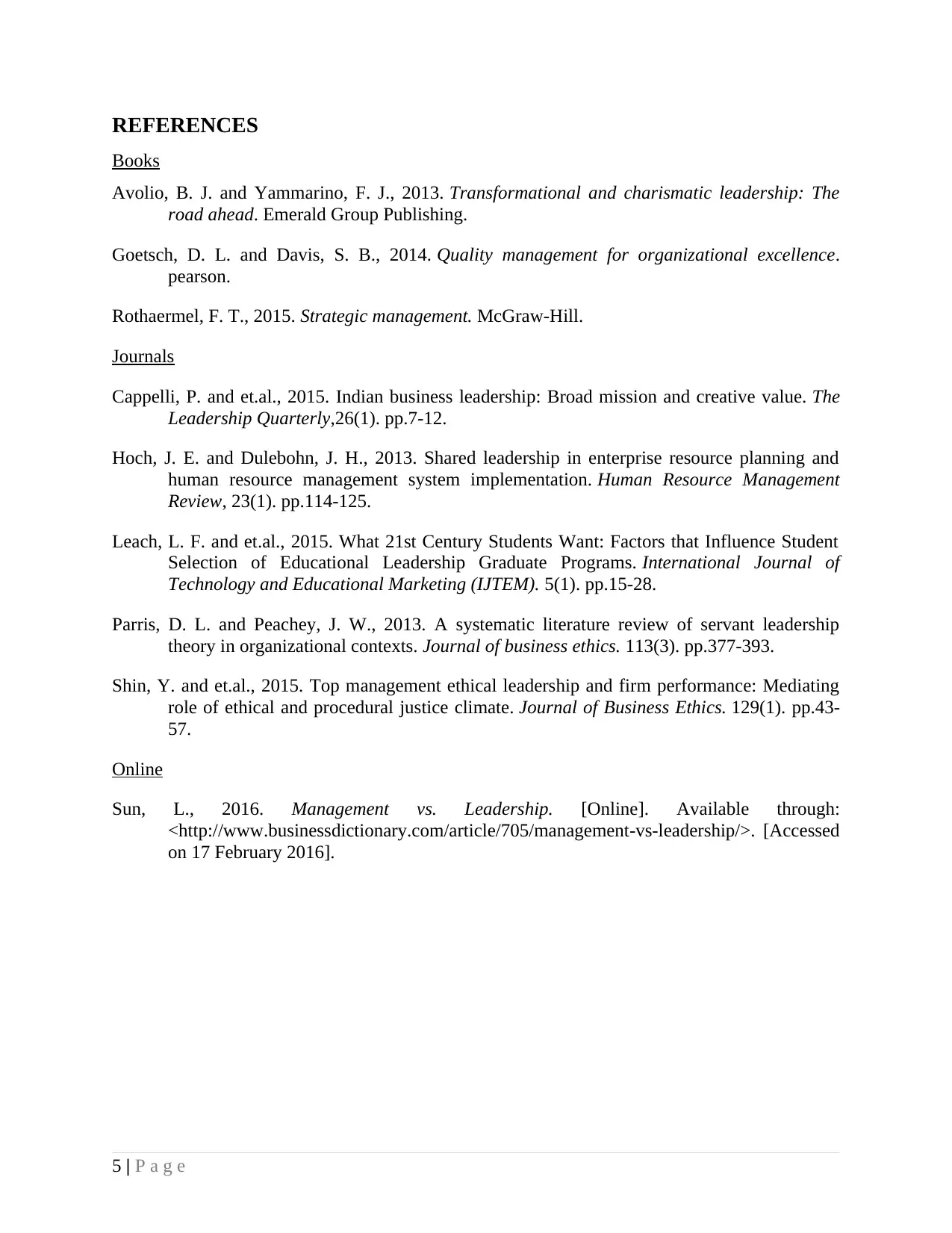
REFERENCES
Books
Avolio, B. J. and Yammarino, F. J., 2013. Transformational and charismatic leadership: The
road ahead. Emerald Group Publishing.
Goetsch, D. L. and Davis, S. B., 2014. Quality management for organizational excellence.
pearson.
Rothaermel, F. T., 2015. Strategic management. McGraw-Hill.
Journals
Cappelli, P. and et.al., 2015. Indian business leadership: Broad mission and creative value. The
Leadership Quarterly,26(1). pp.7-12.
Hoch, J. E. and Dulebohn, J. H., 2013. Shared leadership in enterprise resource planning and
human resource management system implementation. Human Resource Management
Review, 23(1). pp.114-125.
Leach, L. F. and et.al., 2015. What 21st Century Students Want: Factors that Influence Student
Selection of Educational Leadership Graduate Programs. International Journal of
Technology and Educational Marketing (IJTEM). 5(1). pp.15-28.
Parris, D. L. and Peachey, J. W., 2013. A systematic literature review of servant leadership
theory in organizational contexts. Journal of business ethics. 113(3). pp.377-393.
Shin, Y. and et.al., 2015. Top management ethical leadership and firm performance: Mediating
role of ethical and procedural justice climate. Journal of Business Ethics. 129(1). pp.43-
57.
Online
Sun, L., 2016. Management vs. Leadership. [Online]. Available through:
<http://www.businessdictionary.com/article/705/management-vs-leadership/>. [Accessed
on 17 February 2016].
5 | P a g e
Books
Avolio, B. J. and Yammarino, F. J., 2013. Transformational and charismatic leadership: The
road ahead. Emerald Group Publishing.
Goetsch, D. L. and Davis, S. B., 2014. Quality management for organizational excellence.
pearson.
Rothaermel, F. T., 2015. Strategic management. McGraw-Hill.
Journals
Cappelli, P. and et.al., 2015. Indian business leadership: Broad mission and creative value. The
Leadership Quarterly,26(1). pp.7-12.
Hoch, J. E. and Dulebohn, J. H., 2013. Shared leadership in enterprise resource planning and
human resource management system implementation. Human Resource Management
Review, 23(1). pp.114-125.
Leach, L. F. and et.al., 2015. What 21st Century Students Want: Factors that Influence Student
Selection of Educational Leadership Graduate Programs. International Journal of
Technology and Educational Marketing (IJTEM). 5(1). pp.15-28.
Parris, D. L. and Peachey, J. W., 2013. A systematic literature review of servant leadership
theory in organizational contexts. Journal of business ethics. 113(3). pp.377-393.
Shin, Y. and et.al., 2015. Top management ethical leadership and firm performance: Mediating
role of ethical and procedural justice climate. Journal of Business Ethics. 129(1). pp.43-
57.
Online
Sun, L., 2016. Management vs. Leadership. [Online]. Available through:
<http://www.businessdictionary.com/article/705/management-vs-leadership/>. [Accessed
on 17 February 2016].
5 | P a g e
1 out of 7
Related Documents
Your All-in-One AI-Powered Toolkit for Academic Success.
+13062052269
info@desklib.com
Available 24*7 on WhatsApp / Email
![[object Object]](/_next/static/media/star-bottom.7253800d.svg)
Unlock your academic potential
Copyright © 2020–2025 A2Z Services. All Rights Reserved. Developed and managed by ZUCOL.




